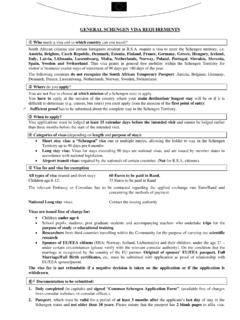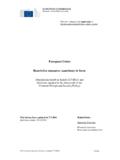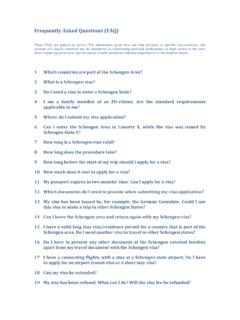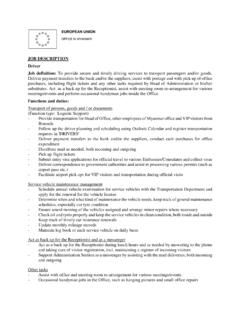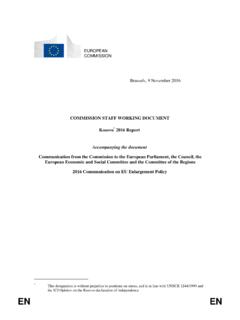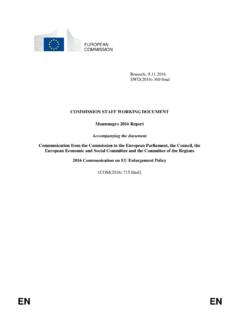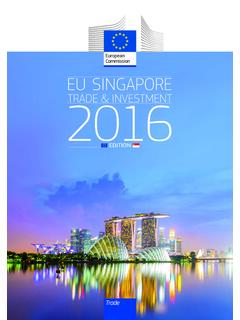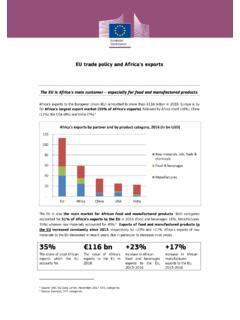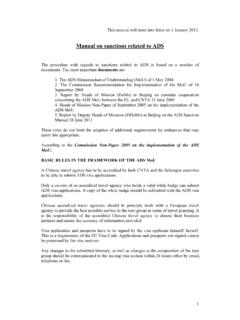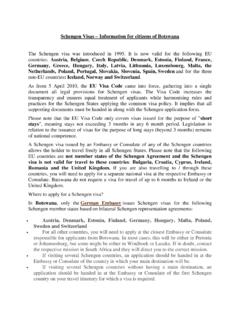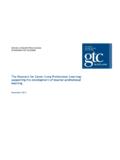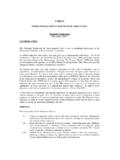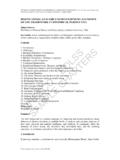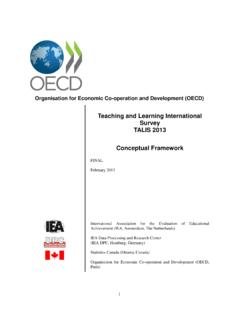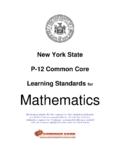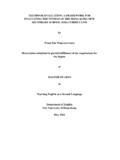Transcription of Introduction to Monitoring and Evaluation Using …
1 Introduction to Monitoring and Evaluation Using the Logical framework Approach Umhlaba Development Services Developed and Presented by: Umhlaba Development Services Noswal Hall, Braamfontein, Johannesburg, South Africa, 2017 Phone +27 11 403-4852 Fax +27 11 403-2670 ii How To Use This Manual This training manual follows a systematic process of Introduction to Monitoring and Evaluation ( M&E ) utilising the logical framework approach to project design. It is structured as a basic guide to M&E within projects designed according to the European Commission EuropeAid Project Cycle Management Handbook, and there is significant reference to the method described therein. Another guide that has been referred to significantly in this manual is the IFAD A Guide for Project M&E.
2 It is recommended that you access these (excellent) documents to continue your further reading in M&E. Ideally this manual provides summarized information to complement a training session facilitated by an experienced M&E practitioner. It can be used as a guide on its own without the formal training, but this is not advised without significant extra reading and mentoring. You are therefore encouraged to seek further information and support. TABLE OF CONTENTS How To Use This Manual ii Introduction to Monitoring and Evaluation and the Logical framework 1 What is Monitoring ? 2 What is a Project? 3 Project Cycle Management 4 PCM and LFA 5 The LogFrame Approach 5 The Steps of Logframe 6 The Project Plan 7 The PPM Vertical Logic 8 Defining Assumptions 10 Project Indicators and Means of Verification10 Project Planning and Monitoring and Evaluation 0 Project Management and M&E 1 Planning for learning and adaptation during implementation 2 How initial Project Design Influences M&E 4 Planning for Monitoring and Evaluation 6 Developing the M&E framework 7 Seeing M&E as a system 8 Purpose and scope of the M&E system 9 The value of the M&E Matrix 10 Performance questions, information needs and indicators 12 Working with qualitative information and indicators 15 Comparing to see change 16 Baseline 17 Alternatives to standard baselines studies 18 What are methods?
3 19 Considerations when choosing your method19 Selecting your method 21 Quantitative and Qualitative methods 21 Examples of Monitoring methods 22 Sampling 23 Necessary conditions and capacities 23 Communication and reporting 25 Implementing M&E 1 Information gathering and organising 2 Participation and M&E 2 Options for verifying data 3 How to collate information 3 Storing M&E information 4 Responsibilities 4 Communication of M&E Results 5 Implementing a learning System 6 Making M&E events more reflective 7 Using steering groups for reflection 7 Annual project review 7 Responding to unplanned needs and request for information 8 Looking for the unintended 9 External Project Reflection: Evaluations 1 External Reflection Exercises 2 Evaluations 2 Types of Evaluation 3 Criteria for Evaluation in Logical framework 3 Preparing for Evaluations 4 Selected Glossary 1 i n t r o d u c t i o n Section 1 Page 1 Introduction to Monitoring and Evaluation and the Logical framework Monitoring and Evaluation learning Outcomes for this Section Reviewing the definitions of Monitoring concepts Understanding the difference between Monitoring and Evaluation Reviewing Project Cycle Management and the Logical framework Acquainting ourselves with the Project Planning Matrix Reviewing the role of Indicators and Means of Verification Section 1 i n t r o d u c t i o n Section 1 Page 2 What is Monitoring ?
4 Project management has the task of establishing sufficient controls over a project to ensure that it stays on track towards the achievement of its objectives. This is done by Monitoring (internal), which is the systematic and continuous collection, analysis and use of information for management control and decision-making. In this instance implementation is seen as a continuous learning process where experience gathered is analysed and fed back into planning and updated implementation approaches. Project Monitoring is an integral part of day-to-day management. It provides information by which management can identify and solve implementation problems, and assess progress. The Logical framework , the implementation schedule, activity schedules, and project budget provide the basis for this Monitoring .
5 There are a number of different levels of Monitoring , each related to what kind of information is relevant, and the regularity of Monitoring . The table below illustrates some examples. Monitoring Level Regularity Which Activities are underway and what progress has been made? Weekly At what rate are means being used and cost incurred in relation to progress in implementation? Monthly Are the desired Results being achieved? Quarterly To what extent are these Results furthering the Project Purpose? What changes in the project environment occur? Do the Assumptions hold true? Six-Monthly Evaluation is an assessment, as systematic and objective as possible, of an ongoing or completed project, programme or policy, its design, implementation and Results. The aim is to determine the relevance and fulfilment of objectives, developmental efficiency, effectiveness, impact and sustainability.
6 An Evaluation should provide information that is credible and useful, enabling the incorporation of lessons learned into the decision-making process of both recipients and donors. Evaluation differs from Monitoring in three respects: Timing Focus Level of Detail i n t r o d u c t i o n Section 1 Page 3 Monitoring and evaluations are interactive and mutually supportive processes. Monitoring and Evaluation of development activities therefore provides government officials, development managers, and civil society with better means for learning from past experience, improving service delivery, planning and allocating resources, and demonstrating results as part of accountability to key stakeholders. In order to fully understand the role of Monitoring in development projects, some revision of project planning and management is necessary.
7 What is a Project? Experiences with development planning were viewed as unsatisfactory prior to 1960s, because national plans tended to lack focus and defined output (they were untargeted), and participation in projects by stakeholders was the prerogative of national governments, and was often neglected. During 1960s-70s period the project became the primary means through which governments of developing countries translated their development plans and policies into programmes of action. Projects were (and still are) seen to act as a crucial coordinating mechanism for the implementation of policy and the integration of resources and institutions. The Project Management Institute defines a project as a temporary endeavour undertaken to create a unique product or service. Temporary means that every project has a definite end.
8 Unique means that the product or service is different in some distinguishing way from all similar products or services. Projects differ in size, scope cost and time, but all have the following characteristics: A start and a finish A life cycle involving a series of phases in between the beginning and end A budget A set of activities which are sequential, unique and non-repetitive Use of resources which may require coordinating Centralised responsibilities for management and implementation Defined roles and relationships for participants in the project i n t r o d u c t i o n Section 1 Page 4 The term project could therefore be taken to mean a group of activities undertaken to produce a Project Purpose in a fixed time frame. In development terms a programme is taken to mean a series of projects whose objectives together contribute to a common Overall Objective, at sector, country or even multi-country level.
9 Project Cycle Management The way in which projects are planned and carried out follows a sequence beginning with an agreed strategy, which leads to an idea for a specific action, oriented to-wards achieving a set of objectives, which then is formulated, implemented, and evaluated with a view to improving the strategy and further action. Project Cycle Management is an approach to managing projects. It determines particular phases of the Project, and outlines specific actions and approaches to be taken within these phases. The PCM approach provides for planning and review processes throughout a cycle, and allows for multiple project cycles to be supported. The project cycle also provides a structure to ensure that stakeholders are consulted and relevant information is available throughout the life of the project, so that informed decisions can be made at key stages in the life of a project.
10 While the scope and scale (and the manner of approach) differs between projects, and the development agencies concerned, some elements remain the same. For example, within all EC programmes the cycle shares three common themes: Key decisions, information requirements and responsibilities are defined at each phase. The phases in the cycle are progressive each phase needs to be completed for the next to be tackled with success. New programming draws on Evaluation to build experience as part of the institutional learning process. Aid co-operation and partnership programmes often involve complex processes that require the active support of many parties. PCM is intended to ensure that stakeholders support the decisions made within projects, and that decisions are based on relevant and sufficient information.
